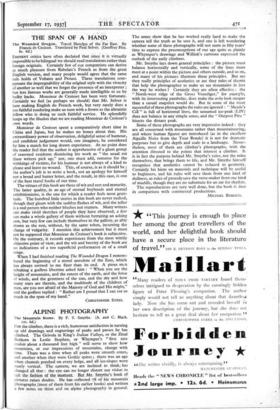ALPINE PHOTOGRAPHY
FOR the climber, there is a rich, humorous satisfaction in turning up old drawings and engravings of peaks and passes he has climbed. The Grivola in King's Italian Valleys, or the Zinal Rothom in Leslie Stephen, or Whymper's " first rate couloir about a thousand feet high " will serve to show how mountains, or our impressions of mountains, change with time. There was a time when all peaks were smooth cones, and another when they were Gothic spires ; there was an age when chamois perched on every ledge, and all ice-slopes were nearly vertical. The camera, we are inclined to think, has changed all that : the eye can no- longer distort our vision to snit the fashion of the moment. But Mr. Smythe's book of Pictures raises doubts. He has collected 78 of his mountain photographs (most of them from his earlier books) and written
few notes on them and on alpine photography in general. The notes show that he has worked really hard to make the camera tell the truth as he sees it, and one is left wondering whether some of these photographs will not seem in fifty years' time to express the preconceptions of our age quite as plainly as Whymper's drawings and Willink's cartoons expressed the outlook of the early climbers.
Mr. Smythe lays down general principles : the picture must balance horizontally and vertically, some of the lines must meet at a point within the picture and others outside, and so on, and many of his pictures illustrate these principles. But are they really principles of aesthetics or are they rules of thumb that help the photographer to make us see mountains in just the way he wishes ? Certainly they are often effective : the " North-west ridge of the Gross Venediger," for examp!e, with its intersecting parabolas, does make the arete look steeper than a casual snapshot would do. But in some of the most successful of these photographs the rules are ignored : Meade's Col " is full of horizontal lines, the unnamed ice-peak (LIV) does not balance in any simple sense, and the " Outpost Pine " bisects the distant peak.
Some of these photographs are very impressive indeed : they are all concerned with mountains rather than mountaineering, and where human figures are introduced (as in the excellent Aiguille Noire from the Tour Ronde) it is not for dramatic purposes but to give depth and scale to a landscape. Never- theless, most of them are climber's photographs, with the attention directed to the points that interest a climber. 1t is in fact the purpose behind Mr. Smythe's rules, not the rules themselves, that brings them to life, and Mr. Smythe himself recognises that aesthetics cannot be reduced to geometry. Certainly his hints on materials and technique will be useful to beginners, and his rules will save them from one kind of dullness, as rules of prosody save the verse-maker from one kind of muddle, though they are no substitute for an ear for rhythm.
The reproductions are very well done, but the book is dear in comparison with continental productions.
MICHAEL ROBERTS.










































 Previous page
Previous page